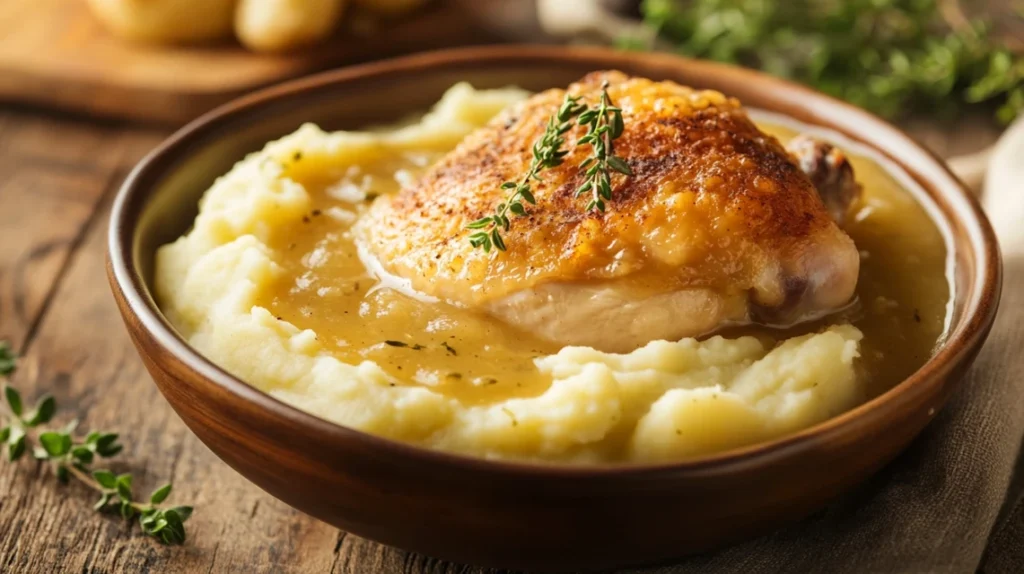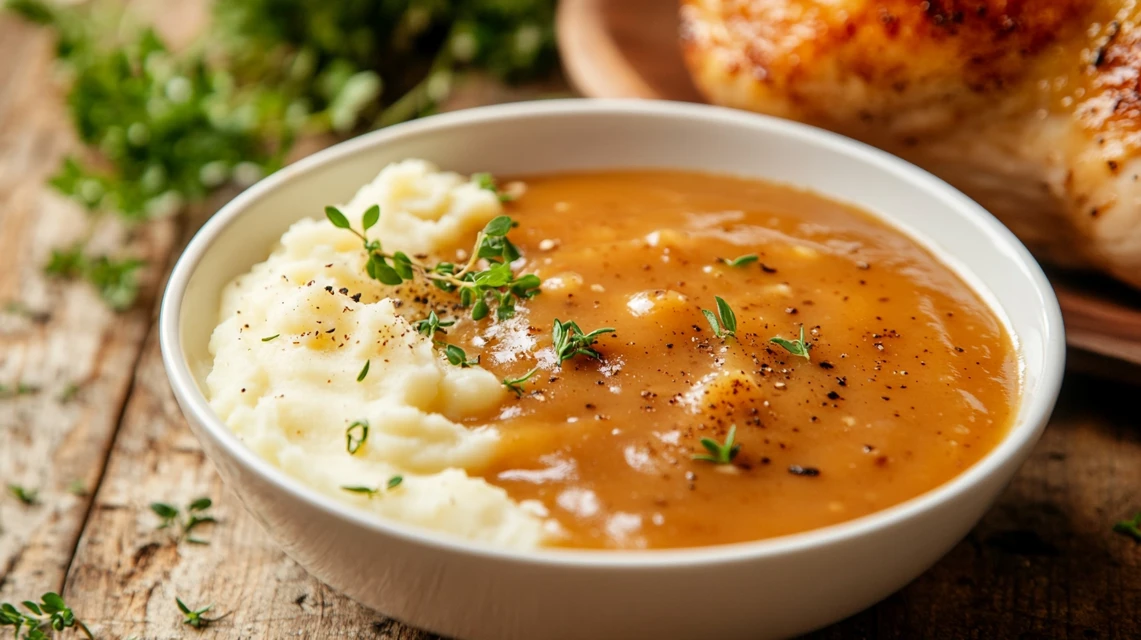How to Make Chicken Gravy Recipe: A Simple, Flavorful Guide
When it comes to comfort food, few things compare to the warm, savory satisfaction of a rich, creamy chicken gravy. Whether you’re serving it over roasted chicken, mashed potatoes, or even biscuits, the right gravy can take your meal to the next level. But, making gravy can feel like an intimidating task for many. The thought of achieving the perfect thickness, smoothness, and flavor can leave you second-guessing your culinary skills.
Worry not! This step-by-step guide will walk you through everything you need to know about making a flawless chicken gravy—from the ingredients to the technique and troubleshooting tips. Let’s dive into the art of gravy-making and transform your next meal into something special.
Introduction to Chicken Gravy: Why It’s a Must-Have for Every Meal
The Magic of Chicken Gravy
Picture this: a crispy, golden roasted chicken resting on your plate, with a steaming heap of mashed potatoes beside it. You reach for the gravy boat and drizzle the rich, savory sauce over everything. The smooth texture, the deep flavor, and the comforting warmth—it’s the kind of meal that brings everyone to the table, eagerly waiting for a bite.
Gravy, often considered a humble addition to a meal, has the power to elevate any dish. Chicken gravy is particularly versatile—whether you’re preparing a simple weekday dinner or a festive holiday feast, this sauce can tie everything together. It’s perfect for bringing out the flavors of roasted meats, grains, and veggies, making it an essential part of home-cooked comfort food.
But let’s be honest—gravy can be tricky to master. Too thick, and it becomes a paste. Too thin, and it turns into broth. The key lies in balancing the ingredients, cooking techniques, and seasoning. In this article, we’ll make sure you get it just right!
Ingredients You’ll Need for the Perfect Chicken Gravy
Before diving into the recipe itself, let’s take a moment to discuss the essential ingredients for a rich, flavorful chicken gravy. Don’t worry, you won’t need any exotic items. Most of these are kitchen staples you likely already have on hand.
1. Chicken Stock or Broth 🐔
The base of any good gravy is the stock. For chicken gravy, you’ll want a good-quality chicken stock or broth. The richer the stock, the more flavorful your gravy will be. If you have homemade stock, that’s fantastic. But, if you’re using store-bought stock, go for a high-quality version with minimal additives. You can also use chicken bouillon cubes dissolved in water if you’re in a pinch.
2. Butter 🧈
Butter is a must for making a roux (the mixture of fat and flour that forms the base of your gravy). It adds richness, smoothness, and flavor. While some recipes call for oil or other fats, butter is the classic choice.
3. Flour 🌾
Flour is what thickens the gravy. When combined with the butter, it forms a roux that gives the gravy its body. You can use all-purpose flour for this, but other types like whole wheat flour can work too if you’re looking to add a bit more depth or texture.
4. Seasoning 🌿
No gravy would be complete without seasoning! Salt and pepper are essential, but you can add a little more flair by incorporating garlic powder, onion powder, dried herbs like thyme or rosemary, or even a splash of Worcestershire sauce for some umami. The idea is to enhance the flavors, not overwhelm them.
5. Optional Ingredients 🍶
You can take your gravy to the next level by adding a few extra ingredients:
- Heavy cream or milk for a richer, creamier texture.
- Soy sauce or balsamic vinegar for a depth of flavor.
- Fresh herbs such as rosemary or thyme to infuse the gravy with aromatic qualities.
These optional ingredients can make your gravy stand out, but keep in mind that a simple chicken gravy with just the basics is also fantastic.
Step-by-Step Guide to Making Chicken Gravy
Now that you have all the ingredients ready, let’s dive into the process. Don’t worry—it’s not as complicated as it seems. By following these simple steps, you’ll have a bowl of rich, velvety chicken gravy in no time.
Step 1: Prepare the Chicken Drippings
If you’ve cooked chicken, chances are there are some delicious drippings left in the pan. These drippings are full of flavor and will serve as the foundation for your gravy. Here’s how to make the most of them:
- After roasting or frying the chicken, remove it from the pan and set it aside to rest.
- If there’s excess fat, use a spoon to remove some of it, leaving about 1 to 2 tablespoons of the fat in the pan. The fat will help in making your roux.
- Optional: You can deglaze the pan by adding a little bit of chicken stock or water and scraping up the browned bits stuck to the bottom of the pan. These crispy bits add a lot of flavor to your gravy.
Step 2: Make the Roux
The roux is a crucial step in making any gravy. It’s what gives your gravy its body and helps it thicken. Here’s how you do it:
- Over medium heat, melt 2 tablespoons of butter (or use the chicken fat left behind).
- Once the butter is melted, sprinkle in 2 tablespoons of all-purpose flour. Stir the mixture with a whisk to ensure the flour is fully incorporated into the fat.
- Continue to cook the roux for 2-3 minutes, stirring constantly. The goal is to cook the flour but not let it burn. The roux should turn a golden color but not too dark.
Step 3: Add the Chicken Stock
Once the roux is ready, it’s time to add the chicken stock, which will transform your roux into gravy. Be sure to follow these steps for a smooth finish:
- Slowly pour in the chicken stock while whisking constantly to avoid lumps.
- Bring the mixture to a simmer, and continue stirring as the gravy thickens. This usually takes about 3-5 minutes.
- As the gravy simmers, keep an eye on the texture. If it becomes too thick, you can add a little more chicken stock or water to loosen it up. If it’s too thin, you can let it cook down a little longer.
Step 4: Season the Gravy
Now that your gravy is taking shape, it’s time to season it. You can use simple salt and pepper, but don’t be afraid to get creative. Try these seasoning options:
- Salt and Pepper: Start with a pinch of salt and a few cracks of black pepper. Taste and adjust as needed.
- Garlic Powder and Onion Powder: These give the gravy an aromatic, savory base.
- Soy Sauce or Worcestershire Sauce: For a deeper, umami-packed flavor.
- Fresh Herbs: Add thyme, rosemary, or even a bay leaf for a fragrant touch.
Step 5: Simmer and Adjust the Consistency
Once you’ve added the seasoning, let the gravy simmer on low heat for another 5-10 minutes. This will allow the flavors to meld together and the gravy to thicken to the perfect consistency. Here are some final tips:
- If the gravy is too thin, continue simmering and stirring. You can also make a slurry by mixing a tablespoon of flour with a bit of water and adding it to the gravy.
- If the gravy is too thick, simply add a bit more stock or water until you reach the desired consistency.
Once your gravy is smooth, thick, and perfectly seasoned, it’s ready to serve!
Common Problems and Solutions for Chicken Gravy
Making gravy is an art, and like any art, it comes with a few challenges. Here are some common issues and how to solve them:
Gravy Too Thin?
If your gravy is too watery, the most common cause is not using enough roux or stock. Here’s how to fix it:
- Simmer it longer: The gravy will thicken as it cooks.
- Use a slurry: Mix equal parts of flour and cold water, then add it to the gravy while stirring. This will thicken it up.
Gravy Too Thick?
If your gravy is too thick and gloopy, simply add more stock or water to thin it out. Stir it continuously to ensure a smooth texture.
Lumpy Gravy?
Lumpy gravy usually happens when the flour isn’t fully incorporated into the fat or if the stock is added too quickly. To fix it:
- Whisk vigorously: This will break up the lumps.
- Strain it: If the lumps are stubborn, strain the gravy through a fine-mesh sieve to remove them.
FAQs About Chicken Gravy Recipe
Can I Use Store-Bought Chicken for the Gravy?
Absolutely! While homemade roasted chicken adds a rich depth of flavor to your gravy, store-bought chicken works just as well. In fact, many people prefer using rotisserie chicken for its convenience and tender meat. The key to making a flavorful chicken gravy lies in the stock or broth, so even with store-bought chicken, you can still create a delicious gravy. Just make sure to use a good-quality chicken broth, whether it’s store-bought or homemade, to enhance the flavor of your gravy.
How Long Can Chicken Gravy Last in the Refrigerator?
If you have leftover chicken gravy, don’t worry—you can store it for later! Chicken gravy can be kept in the refrigerator for up to 3-4 days. Just make sure to store it in an airtight container to preserve its freshness. When you’re ready to use it again, gently reheat it over low heat, stirring occasionally to maintain the right texture. If it has thickened too much, you can always add a little water or extra stock to loosen it up.
Is Chicken Gravy Gluten-Free?
Great question! Traditional chicken gravy made with flour (for the roux) does contain gluten. However, if you’re following a gluten-free diet, you can easily make gluten-free chicken gravy by using alternatives. Instead of regular wheat flour, you can use gluten-free flour, cornstarch, or arrowroot powder to thicken your gravy. The rest of the ingredients, like chicken broth, butter, and seasonings, are typically gluten-free, so you’re all set! Just make sure to double-check the labels of your ingredients to ensure they don’t contain hidden gluten.

Conclusion: Enjoying the Perfect Chicken Gravy
Making chicken gravy might seem like a daunting task at first, but with the right technique and ingredients, it’s easier than you think! Whether you’re a seasoned cook or a kitchen novice, you can master the art of gravy-making in no time. By following the step-by-step guide—starting with the rich base of chicken stock, creating a perfect roux, seasoning with care, and adjusting the consistency—you’ll be able to create a gravy that will elevate any meal.
The beauty of chicken gravy is its versatility. You can make it as rich or light as you like, add a variety of seasonings to suit your taste, and even use it to enhance other dishes. From a simple weekday dinner to a holiday feast, this chicken gravy recipe will become an essential part of your culinary repertoire.
So, what are you waiting for? Try this recipe next time you’re in the kitchen, and watch how a small addition like gravy can transform your entire meal. And remember, even if things don’t go perfectly the first time, cooking is all about experimenting and having fun. You’ll only get better with practice!
Feel free to share your own variations of the recipe or any questions you might have in the comments. Whether you’re making a big batch for a family dinner or just need a little extra sauce for your chicken, this recipe is guaranteed to be a hit. 🍽️✨
- Chicken Soup Recipe for Cold – If you’re looking to create a comforting meal, pairing your chicken gravy with a warm, soothing chicken soup might be the perfect combination.
- Best Chicken Salad Recipe – After preparing the gravy, you might want to use it in a creative chicken salad. This link will guide your readers to a healthy and delicious chicken salad recipe.
- Can You Cook Chicken and Seafood Together? – Some people like to experiment by pairing chicken with other proteins. This link explores how you can combine chicken and seafood for unique meals, and might help readers decide if they want to try new combinations.
- What is the Secret to Creme Brulee?
- A smooth, velvety texture is key in many dishes, both savory and sweet. This link provides insight into the secret of perfect texture, relevant to mastering the velvety consistency of chicken gravy.
Additional Related Content
- Italian Penicillin Soup – Another great soup recipe to enjoy alongside your chicken gravy, bringing more depth and flavor.
- Delmonico Steak: Everything You Need to Know – If you’re planning a more substantial meal, why not pair your chicken gravy with a delicious steak? This link explains everything about Delmonico steaks.
1. Chicken Gravy and Health
- Link: Health Benefits of Chicken
- Why it’s relevant: This link directs readers to a trusted health website explaining the nutritional benefits of chicken, which complements your content by highlighting the importance of this ingredient.
2. Recipe for Chicken Gravy Variations
- Link: How to Make Chicken Gravy with Cream
- Why it’s relevant: This article offers a variation of chicken gravy with cream. Linking to this page will allow your readers to explore different methods of making chicken gravy.
3. Chicken Gravy Pairing Suggestions
- Link: Best Foods to Serve with Chicken Gravy
- Why it’s relevant: For those who are looking for food pairings with chicken gravy, this external link suggests side dishes and meals that go perfectly with chicken gravy.
4. Cooking Techniques and Tips for Chicken
- Link: How to Roast Chicken Perfectly
- Why it’s relevant: Many readers might be interested in roasting the perfect chicken to pair with their homemade chicken gravy. This trusted guide offers cooking tips for a perfectly roasted chicken.
5. Understanding the Science of Gravy Making
- Link: The Science of Gravy
- Why it’s relevant: An authoritative source that explains the science behind making the perfect gravy, which can provide valuable insights for your readers interested in perfecting their gravy-making skills.
6. Gluten-Free Chicken Gravy Recipe
- Link: Gluten-Free Gravy Recipes
- Why it’s relevant: This link leads to gluten-free gravy recipes for those looking for a gluten-free version of chicken gravy, making your content accessible to a wider audience.
7. Chicken Gravy’s Cultural Influence
- Link: The History of Gravy in Various Cultures
- Why it’s relevant: If your audience is interested in food history, this external link dives into the cultural significance of gravy, helping them appreciate the dish’s roots and variations across cultures.
8. Gravy for Special Diets
- Link: Low-Carb Gravy Recipes
- Why it’s relevant: This link offers a low-carb alternative for readers who follow a specific diet but still want to enjoy gravy. It connects well with readers looking for healthier alternatives to traditional gravy.
- Where to place them: Outbound links should be included naturally within your content. You can add them as part of your explanations, recipes, or suggestions. Be sure that the links are contextually relevant and enhance the value of your content.
- Anchor Text: The text linking to the external site should be descriptive. For example, instead of “click here,” use anchor text like “Learn more about the health benefits of chicken” or “Explore variations of chicken gravy with cream.”

